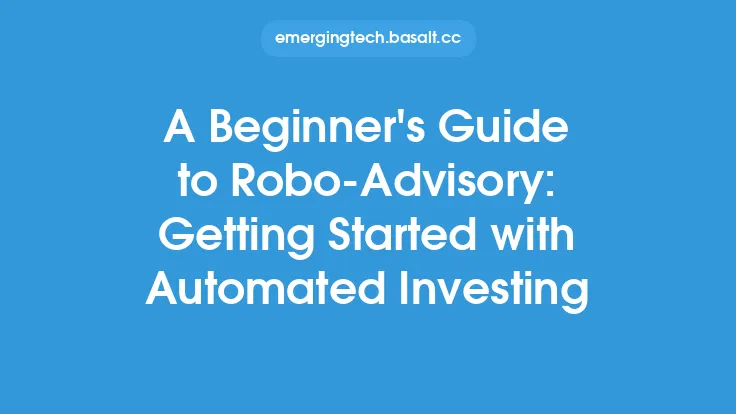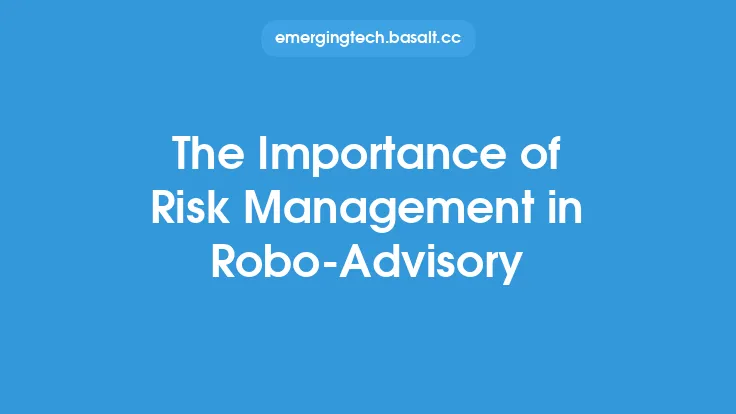The financial industry has undergone significant transformations in recent years, and one of the key drivers of this change is the emergence of robo-advisors. These automated investment platforms have revolutionized the way people invest, making it more accessible, affordable, and efficient. At its core, a robo-advisor is a digital platform that uses algorithms to manage and optimize investment portfolios. This is achieved through a combination of machine learning, data analysis, and automated trading, allowing for real-time portfolio rebalancing and optimization.
Introduction to Robo-Advisory
Robo-advisors have been gaining popularity since their inception, and their growth can be attributed to the benefits they offer to investors. One of the primary advantages of robo-advisors is their ability to provide diversified investment portfolios at a lower cost compared to traditional financial advisors. This is because robo-advisors operate with minimal human intervention, reducing the need for manual portfolio management and the associated costs. Additionally, robo-advisors offer a high degree of transparency, allowing investors to track their portfolio performance in real-time and make informed decisions.
How Robo-Advisors Work
The inner workings of a robo-advisor involve a complex array of algorithms, data feeds, and trading systems. When an investor signs up for a robo-advisor, they are typically asked to complete a risk assessment questionnaire, which helps the platform determine their investment goals, risk tolerance, and time horizon. This information is then used to create a personalized investment portfolio, which is composed of a diversified mix of assets, such as stocks, bonds, and exchange-traded funds (ETFs). The portfolio is then continuously monitored and optimized by the robo-advisor's algorithms, which take into account market trends, economic indicators, and other relevant data points.
Key Components of Robo-Advisory
There are several key components that make up a robo-advisor, including the user interface, portfolio management system, risk management system, and trading system. The user interface is the platform's front-end, where investors can access their portfolio, view performance metrics, and make changes to their investment strategy. The portfolio management system is the brain of the robo-advisor, responsible for creating and optimizing investment portfolios. The risk management system is designed to mitigate potential losses by identifying and responding to market risks, such as volatility and liquidity risks. The trading system is responsible for executing trades, ensuring that portfolio rebalancing is done efficiently and at the best possible prices.
Benefits of Robo-Advisory
The benefits of robo-advisory are numerous, and they can be summarized into several key areas. Firstly, robo-advisors offer a high degree of convenience, allowing investors to manage their portfolios from anywhere, at any time. Secondly, robo-advisors provide a low-cost alternative to traditional financial advisors, making investment more accessible to a wider range of people. Thirdly, robo-advisors offer a high degree of transparency, allowing investors to track their portfolio performance in real-time. Finally, robo-advisors are able to optimize investment portfolios continuously, ensuring that investors' assets are working as hard as possible to achieve their investment goals.
Technical Aspects of Robo-Advisory
From a technical perspective, robo-advisors rely on a range of advanced technologies, including machine learning, natural language processing, and data analytics. Machine learning algorithms are used to analyze large datasets, identify patterns, and make predictions about future market trends. Natural language processing is used to analyze and interpret large amounts of unstructured data, such as financial news and social media posts. Data analytics is used to analyze portfolio performance, identify areas for improvement, and optimize investment strategies. Additionally, robo-advisors use a range of programming languages, including Python, Java, and C++, to build and maintain their platforms.
Security and Regulation
Security and regulation are critical components of the robo-advisory industry. Robo-advisors must comply with a range of regulatory requirements, including anti-money laundering (AML) and know-your-customer (KYC) rules. Additionally, robo-advisors must ensure that their platforms are secure, using advanced encryption and authentication protocols to protect investor data. In terms of regulation, robo-advisors are subject to oversight by regulatory bodies, such as the Securities and Exchange Commission (SEC) in the United States. These regulatory bodies ensure that robo-advisors operate in a fair and transparent manner, and that investors are protected from potential risks.
Conclusion
In conclusion, robo-advisors are revolutionizing the investment landscape, offering a range of benefits to investors, including convenience, low costs, and transparency. The technical aspects of robo-advisory are complex, involving advanced technologies such as machine learning and data analytics. However, the end result is a platform that is able to optimize investment portfolios continuously, ensuring that investors' assets are working as hard as possible to achieve their investment goals. As the robo-advisory industry continues to evolve, it is likely that we will see even more innovative solutions emerge, further transforming the way we invest and manage our finances.





